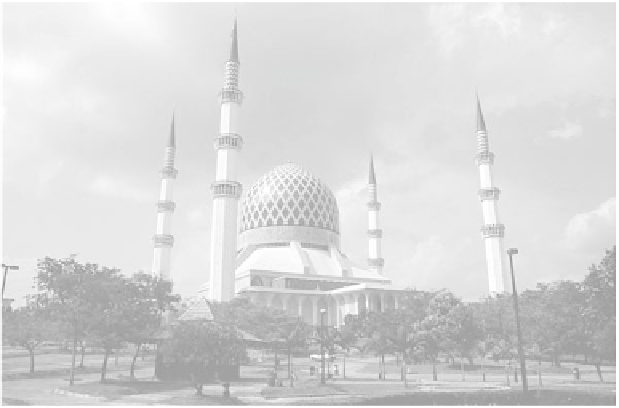Geography Reference
In-Depth Information
Under the communists who took over China in
1949, the faith was suppressed and followers persecuted.
For decades, Christians worshipped in “underground
churches” commonly known as “house churches” to
evade arrest for “disturbing public order.” In recent years,
the government has eased its pressure and in 2007, Presi-
dent Hu Jin-tao told Politburo leaders that, “The knowl-
edge and strength of religious people must be mustered to
build a prosperous society .” The government estimates
21 million Roman Catholics and Protestants in the coun-
try . Outside estimates put the number at 70 million. Even
greater numbers continue to worship in house churches.
ings about a new way of life provided welcome structure
in what was then a chaotic Arab world, and converts
quickly accumulated.
Muslims
(those who submit to
God) formed armies to invade and conquer the lands of
infidels,
or non-believers. Clashes with other established
faiths resulted in the death of millions on all sides. Un-
fortunately , religious conflicts associated with Islam
versus other belief systems still exist.
Muslims believe in one God,
Allah,
and recognize
Muhammad as His prophet. Their house of worship is
called a
mosque
(Figure 1-10). They also view Jesus Christ
as a prophet. Like the Jews, they avoid pork, perceiving it
as unclean. T To Muslims, the will of Allah is absolute. The
Word of Allah is contained in the
Koran,
or
Qur'an,
which
is Arabic for “recitation.” Pivotal to being a good Muslim
are the
Five Pillars of Islam.
These are: acknowledgment
of Allah as God and Muhammad as His Prophet; prayer five
times a day wherever one is (Friday is “mosque-day”); a
month of daytime fasting (known as
Ramadan
); the giving
of alms; and at least one pilgrimage to Mecca. Held in the
last month of the lunar calendar, this yearly event is known
as the
hajj
and involves the convergence of millions of pil-
grims in the holy cities of Mecca and Medina.
Dissension over succession to the Caliphate (ruling)
authority eventually caused division in Islam, resulting
in two major branches and several other sects. The ma-
jority of Muslims are orthodox Sunnis. The breakaway
Shiites account for less than 15 percent. Shi'ism (
Shiah
)
became rooted in Persia (Iran) in the sixteenth century
and subsequently spread via Iraq and Afghanistan to
Pakistan. It has even influenced Sunni Islam in India.
Shiites are generally more fervent in their beliefs and
more emotional in their practices. T To them, religious
ISLAM
Islam, which translates as
submission to God,
is the youngest
of the major religions. It originated around the subse-
quently holy cities of
Mecca (Makkah
) and
Medina (al
Madinah)
in Arabia in the sixth century ADIslam swept
east across Asia with successive waves of conquerors,
traders, and missionaries. It replaced earlier religions in
many areas. For example, Buddhism and Hinduism were
once important in Indonesia but were virtually eradicated
under the fervor of Islam. Islam is the dominant religion in
Pakistan, Bangladesh, Malaysia, Indonesia, and Brunei. It is
also a potent force in several other regions such as northern
India and the southern Philippines. Y ou will learn more
about Islam in its regional contexts in later chapters.
Coming from the same core area, Islam has links to
both Christianity and Judaism. It, too, is a monotheistic
faith. Following a series of divine revelations,
Muhammad
(571-632) began preaching in Mecca and later Medina
after being forced to flee there by his enemies. His teach-
Figure 1-10
This magnificent mosque is at Shah Alam, the new
capital of Selangor Province west of Kuala
Lumpur , Malaysia. Named for the Sultan Salahuddin
Abdul Aziz Masjid, it was built in 1988 and holds
16,000 people. The mosque is oriented to face the
holy city of Mecca. Loudspeakers on the minarets
announce the call to prayer five times a day .
Photograph courtesy of B. A. Weightman.


















Search WWH ::

Custom Search